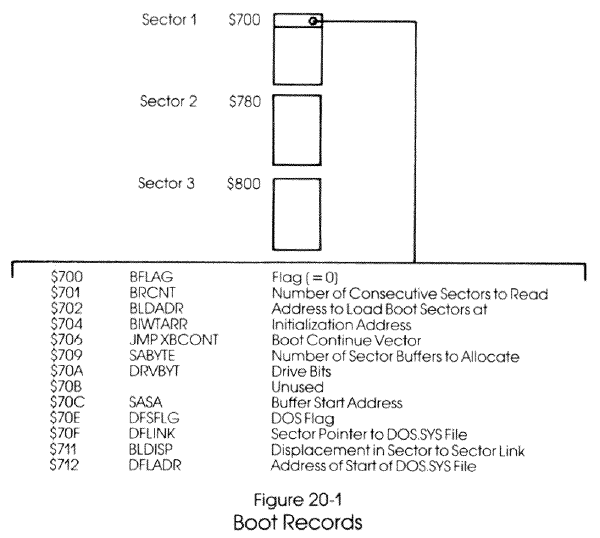THE
BOOT
PROCESS
When the Atari computer is turned on, the routines in the OS ROM will
(under certain conditions) read the first sector from the disk in drive
one into memory. It will then examine certain specific locations in this
record to decide how to boot the disk. In the following discussion, refer
to Figure 20-1. The OS ROM code will load BRCNT consecutive sectors (starting
with sector one) onto memory, starting at the address contained in BLDADR.
When the OS ROM code has finished this task, it will make a JSR call to
the code that is seven bytes into the start of the boot area. In the case
of FMS, this is the IMP XBCONT instruction at $706. The XBCONT code will
continue the boot load process.
The XBCONT code examines the DFSFLG to see if a DOS.SYS file exists.
If the file exists, then the sector number of the first sector in DOS.SYS
will be in DFLINK. The routine will then read all the sectors in the chain
starting at DFLINK into the memory area pointed to by DFLADR. When the
entire DOS.SYS file is read into memory, XBCONT returns to the OS ROM code.
The OS ROM code will eventually vector through the BINTADR so that
the FMS can initialize itself. In the DOS 2.0S system, BINTADR points into
the DUP.SYS code. DUP.SYS then receives control from the OS ROM rather
than the FMS. One of the tasks that DUP.SYS performs during its initialization
is to call the FMS initialization routine.
XBCONT
The XBCONT routine ($714) is entered by the OS ROM code during the
boot process to allow the boot process to continue in the manner best suited
for the code being booted.
Functions:
1) If the DFSFLG indicates that a DOS.SYS file does not exist, then the OS ROM is returned to with the carry set to indicate that the boot has failed.
2) The address contained in DFLADR is moved to the zero page address pointer, ZBUFP, and to the DCB buffer pointer field, DCBBUF.
3) The sector number contained in DFLINK is loaded into the A,Y register pair, the carry is cleared to indicate read, and BSIO is called to read a DOS.SYS sector.
4) The next sector Link is obtained from the link field of the data sector just read.
5) If the sector link value is zero, then the DOS.SYS end-of-file has been reached. The OS ROM will be returned to with the carry clear to indicate that the boot read was good.
6) If the sector link value is not zero, then the zero page buffer pointer and the DCB buffer pointer are incremented by the amount of data in the sector (125 for 810 drives, 253 for 815 drives).
7) The process continues by reading the next sector into memory.

Return to Table of Contents | Previous Chapter | Next Chapter

